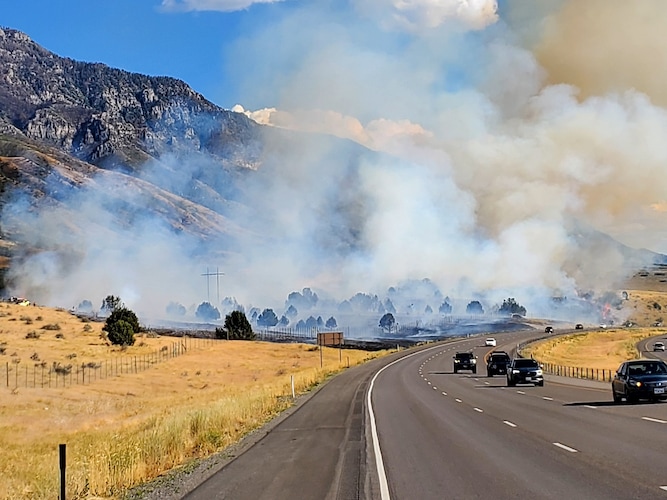Utah’s wildfire season may start later this year, thanks in part to frequent storms passing over the state, experts say. But it could also be more intense.
The season usually reaches its peak in July or August, but this year, the Unified Fire Authority is planning for a September peak.
That’s because a rainier climate this winter and spring has dampened places that would typically be most at risk for flames, and it’s going to take longer for those areas to dry out, United Fire Authority spokesperson Kelly Bird said.
“This year is very different from years past,” he said. “We’re anticipating it to hold off for a while.”
Greater risk at lower elevations

(Utah Wildfire Info) Firefighters work the Precision Fire along Interstate 15 south of Santaquin on Saturday, July 16, 2022. Lower elevations are more at risk of wildfires during wet years like 2023.
During dry years, higher elevation areas are typically most at risk. But lower elevation areas are at the highest risk during a wet year like this one, said Phillip Dennison, a University of Utah geography professor specializing in wildfire research.
Precipitation levels in Utah this year are already above the 30-year average, according to the Utah Division of Water Resources. All of that rain makes lower elevation plant growth much thicker, Dennison said, which becomes a danger once they “cure,” or when they dry out enough to become a fire risk.
Though wildfires may start later, the extra rain likely will feed that plant life, and could create an excess of what officials call “light, flashy fuels,” Bird said.
In the western part of the Salt Lake Valley, those fuels include grasses, shrubs and sagebrush, which are more difficult to mitigate ahead of wildfire season.
Mitigation teams in the eastern Salt Lake Valley have been cutting down trees and clearing out larger sources of fire fuel from urban areas for about a month.
But the foliage in the west is not as easy to clear out because there is nothing to cut down — it’s mostly plant life below the knee, Bird said.
The key will be seeing how high wind speeds are later in the year, Dennison said, adding that red flag warnings — which signify warm temperatures, low humidity and strong winds — will be “really important for determining how many fire ignitions turn into large fires.”
Crews ‘waiting to see what happens’
(Al Hartmann | The Salt Lake Tribune) Smoke from wildfires in the West drifts into northern Utah making visibility dismal and air quality less than healthy in August 2015.
Despite the delay, officials are still advising everyone to be cautious as the valley starts to enter “firework season,” Bird said. Fireworks should not be used over grassy areas or public lands, and instead should be kept over pavement. He encouraged those celebrating upcoming holidays to follow regulations closely.
“We’re still asking people to look at the restriction map,” he said, referencing a Unified Fire Authority map that shows where fireworks are restricted. “We’re wanting people to still be diligent.”
That guidance goes for people across the state, said Karl Hunt, spokesperson for the Division of Forestry, Fire and State Lands.
“I like to say the southern part of the state is deceptively green,” Hunt said. “But it’s still dry.”
Be sure to douse a campfire and stir it with a shovel, he said, and don’t drive a trailer with dragging chains, which can cause sparks. If you are using a firearm on a shooting range, have a clear backstop to prevent bullets from sparking as well.
“Use fire sense,” he said. “Fire sense is common sense.”
Since the division’s launch of its Fire Sense Campaign in 2021, the state has seen a 60% decrease in human-caused wildfires.
“We’re thankful that Mother Nature has given us a little reprieve here,” Hunt said. “But our crews are ready and we’re waiting to see what happens.”







